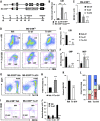Derepression of the DNA Methylation Machinery of the Gata1 Gene Triggers the Differentiation Cue for Erythropoiesis
- PMID: 28069743
- PMCID: PMC5376630
- DOI: 10.1128/MCB.00592-16
Derepression of the DNA Methylation Machinery of the Gata1 Gene Triggers the Differentiation Cue for Erythropoiesis
Abstract
GATA1 is a critical regulator of erythropoiesis. While the mechanisms underlying the high-level expression of GATA1 in maturing erythroid cells have been studied extensively, the initial activation of the Gata1 gene in early hematopoietic progenitors remains to be elucidated. We previously identified a hematopoietic stem and progenitor cell (HSPC)-specific silencer element (the Gata1 methylation-determining region [G1MDR]) that recruits DNA methyltransferase 1 (Dnmt1) and provokes methylation of the Gata1 gene enhancer. In the present study, we hypothesized that removal of the G1MDR-mediated silencing machinery is the molecular basis of the initial activation of the Gata1 gene and erythropoiesis. To address this hypothesis, we generated transgenic mouse lines harboring a Gata1 bacterial artificial chromosome in which the G1MDR was deleted. The mice exhibited abundant GATA1 expression in HSPCs, in a GATA2-dependent manner. The ectopic GATA1 expression repressed Gata2 transcription and induced erythropoiesis and apoptosis of HSPCs. Furthermore, genetic deletion of Dnmt1 in HSPCs activated Gata1 expression and depleted HSPCs, thus recapitulating the HSC phenotype associated with GATA1 gain of function. These results demonstrate that the G1MDR holds the key to HSPC maintenance and suggest that release from this suppressive mechanism is a fundamental requirement for subsequent initiation of erythroid differentiation.
Keywords: Gata1 gene regulation; erythropoiesis; hematopoietic stem and progenitor cell.
Copyright © 2017 American Society for Microbiology.
Figures









Similar articles
-
The Gata1 5' region harbors distinct cis-regulatory modules that direct gene activation in erythroid cells and gene inactivation in HSCs.Blood. 2013 Nov 14;122(20):3450-60. doi: 10.1182/blood-2013-01-476911. Epub 2013 Sep 10. Blood. 2013. PMID: 24021675
-
A regulatory network governing Gata1 and Gata2 gene transcription orchestrates erythroid lineage differentiation.Int J Hematol. 2014 Nov;100(5):417-24. doi: 10.1007/s12185-014-1568-0. Epub 2014 Mar 18. Int J Hematol. 2014. PMID: 24638828 Review.
-
GATA factor switching from GATA2 to GATA1 contributes to erythroid differentiation.Genes Cells. 2013 Nov;18(11):921-33. doi: 10.1111/gtc.12086. Epub 2013 Aug 1. Genes Cells. 2013. PMID: 23911012
-
Distinct and overlapping DNMT1 interactions with multiple transcription factors in erythroid cells: Evidence for co-repressor functions.Biochim Biophys Acta. 2016 Dec;1859(12):1515-1526. doi: 10.1016/j.bbagrm.2016.09.007. Epub 2016 Sep 28. Biochim Biophys Acta. 2016. PMID: 27693117
-
GATA factor switching during erythroid differentiation.Curr Opin Hematol. 2010 May;17(3):163-8. doi: 10.1097/MOH.0b013e32833800b8. Curr Opin Hematol. 2010. PMID: 20216212 Review.
Cited by
-
Murine erythroid differentiation kinetics in vivo under normal and anemic stress conditions.Blood Adv. 2023 Oct 10;7(19):5727-5732. doi: 10.1182/bloodadvances.2023010088. Blood Adv. 2023. PMID: 37552129 Free PMC article.
-
Enhancer DNA methylation in acute myeloid leukemia and myelodysplastic syndromes.Cell Mol Life Sci. 2018 Jun;75(11):1999-2009. doi: 10.1007/s00018-018-2783-2. Epub 2018 Feb 26. Cell Mol Life Sci. 2018. PMID: 29484447 Free PMC article. Review.
-
Reducing Inflammatory Cytokine Production from Renal Collecting Duct Cells by Inhibiting GATA2 Ameliorates Acute Kidney Injury.Mol Cell Biol. 2017 Oct 27;37(22):e00211-17. doi: 10.1128/MCB.00211-17. Print 2017 Nov 15. Mol Cell Biol. 2017. PMID: 28807932 Free PMC article.
-
Regulated GATA1 expression as a universal gene therapy for Diamond-Blackfan anemia.Cell Stem Cell. 2025 Jan 2;32(1):38-52.e6. doi: 10.1016/j.stem.2024.10.012. Epub 2024 Nov 11. Cell Stem Cell. 2025. PMID: 39532107 Free PMC article.
-
Epigenetic activities in erythroid cell gene regulation.Semin Hematol. 2021 Jan;58(1):4-9. doi: 10.1053/j.seminhematol.2020.11.007. Epub 2020 Dec 15. Semin Hematol. 2021. PMID: 33509442 Free PMC article.
References
-
- Takahashi S, Komeno T, Suwabe N, Yoh K, Nakajima O, Nishimura S, Kuroha T, Nagasawa T, Yamamoto M. 1998. Role of GATA-1 in proliferation and differentiation of definitive erythroid and megakaryocytic cells in vivo. Blood 92:434–442. - PubMed
-
- Zon LI, Yamaguchi Y, Yee K, Albee EA, Kimura A, Bennett JC, Orkin SH, Ackerman SJ. 1993. Expression of mRNA for the GATA-binding proteins in human eosinophils and basophils: potential role in gene transcription. Blood 81:3234–3241. - PubMed
Publication types
MeSH terms
Substances
LinkOut - more resources
Full Text Sources
Other Literature Sources
Molecular Biology Databases
